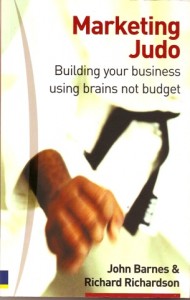The one-sentence summary
When considering creative ideas, concentrate on the size of the idea, not the size of the budget.
- You don’t need a big budget to build a brand
- The principles of judo, where brains matter more than brawn, can help (Ju means flexible and Do means way)
- The authors rejuvenated the Harry Ramsden’s brand and now run their own company called Marketing Judo
- The seven stages they propose are:
1. Getting the basics right (Don’t spend on marketing till the basics are working)
2. Picking the right partner (staff, advisors, celebrities, other brands)
3. Choosing the right opponent (sloths, not Geesinks*)
4. Getting the crowd on your side (creating your own fan club)
5. Using your size to your advantage (keeping fit, moving fast, staying focused)
6. Doing the unexpected (the competitive advantage of unpredictability)
7. Keeping your balance (the benefits of planning for the unexpected)
WHAT’S GOOD ABOUT IT
- The point about choosing your competition is well made:
~ *Spotting corporate sloths is a good way to identify competition you can beat
~ *Don’t choose Geesinks (Anton Geesink was a 6’ 6’’ judo player who beat everyone in the 1964 Olympics and forced the introduction of weight classification for the first time)
- There are examples of those who get it right: Pret a Manger, Kettle Foods, Cobra Beer, Eddie Stobart (and Walkers as a Geesink)
- Having a Brains Day not a Budget Day is a good way of leading a brainstorm
- The book is short and pithy
- The method can be followed simply and used with clients
WHAT YOU HAVE TO WATCH
- The orientation is all about what to do when you have no budget. This could be counter-productive with clients if handled insensitively
- The majority of the examples are retail-based
- The judo analogy is pushed a bit far in certain places

